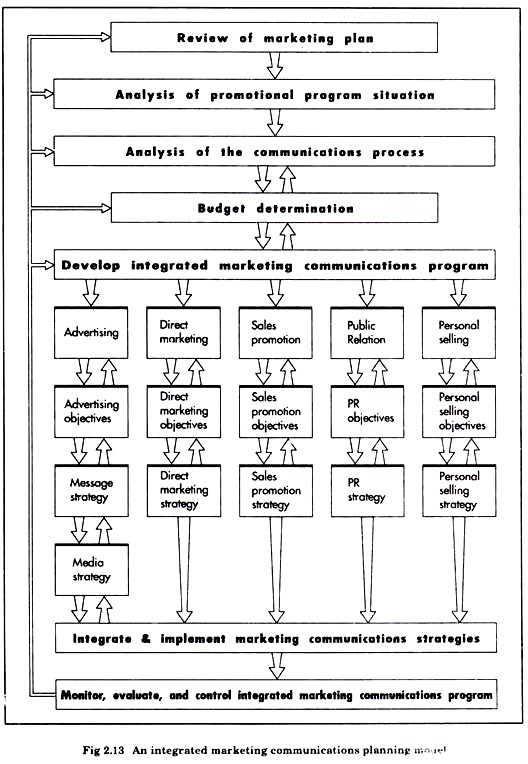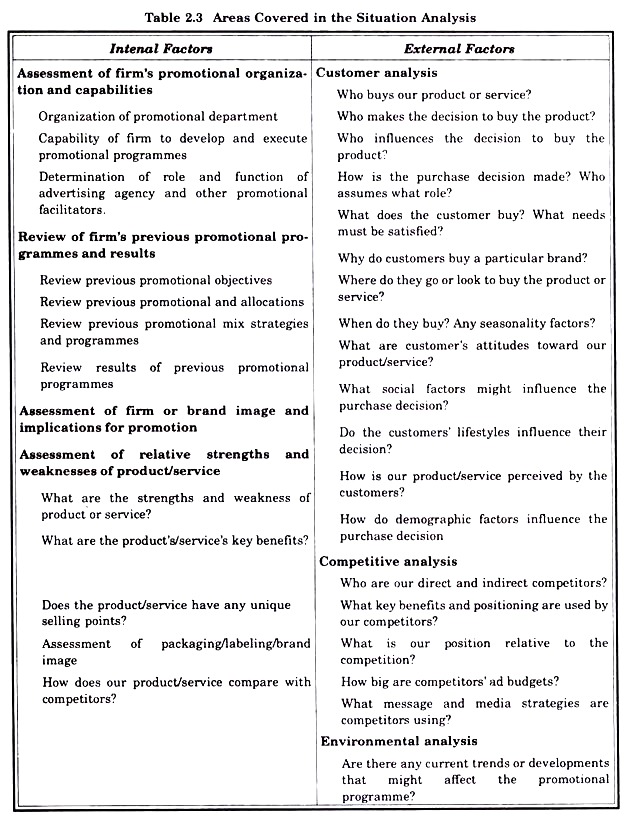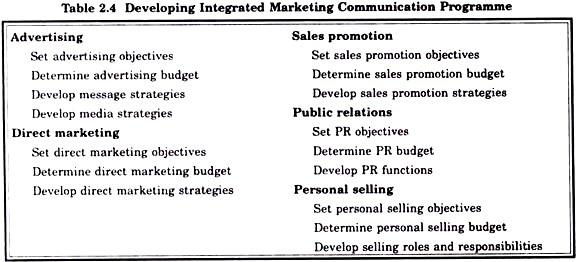This article throws light upon the six main steps of integrated marketing communication planning process. The steps are: 1. Review of Marketing Plan 2. Promotional Programme Situational Analysis 3. Analysis of Communication Process 4. Budget Determination 5. Developing the Integrated Marketing Communication Programme 6. Mentoring, Evaluation and Control. 
Step # 1. Review of Marketing Plan:
Before developing a promotional programme, it is important to understand where the company’s (or the brand) current position is in the market, where it intends to go and how it plan to get there. A marketing plan is a written document describing the overall marketing strategy and programme developed for the organization, a particular product line or a brand.
Marketing plan included the following basic elements:
1. A detailed situation analysis that consists of an internal marketing audit and an external analysis of the market competition and environmental factors.
2. Specific marketing objectives that provide direction, a time frame for marketing activities, and a mechanism for measuring performance.
3. A marketing strategy and programme that include selection of target market(s) decisions and plans for the four elements of the marketing mix.
4. A programme for implementing the marketing strategy, including determining specific tasks to be performed and responsibilities.
5. A process for monitoring and evaluating performance and providing feed back so that proper control can be maintained and any necessary changes made in the marketing strategy or tactics.
A promotional programme is an integral part of the marketing strategy. It will give an idea of the role of advertising and other promotional mix element will play in the overall marketing programme.
Step # 2. Promotional Programme Situational Analysis:
The next step in developing promotional plan is to conduct the situation analysis. A situation analysis involves the internal analysis and external analysis. Internal analysis assesses relevant area involving the product/service offering and the firm itself.
The capabilities of the firm and its ability to develop and implement a successful promotional programme, the organization of promotional department and the success and failures of past programmes are reviewed.
The analysis study the relative advantages and disadvantages of performing the promotional functions. For example, the internal analysis may indicate the firm is not capable of planning, implementing and managing certain areas of the promotional programme.
If this is the case, it would be wise to look for assistance from an advertising agency or some other promotional facilitator. If the organization is already using an advertising agency, the focus will be on the quality of the agency’s work and the results achieved by past and/current campaigns.
The other aspect of internal analysis is assessing the strengths and weaknesses of the firm or the brand from an image perspective. Often, the image of the firm brings to the market will have a significant impact on its promotional programme.
Another aspect of the internal analysis is the assessment of the relative strengths and weaknesses of the product or service in comparison to its competitors, unique selling points or benefits it has, its price, design, packaging to help the creative personnel to develop advertising message for the brand.
External analysis focuses its attention on the firm’s customers, market segments, positioning strategies, and competitors (Table 2.3). An important part of the external analysis is a detailed consideration of customers in terms of their characteristics and buying patterns, their decision processes, and factors influencing their purchase decisions.
Attention must also be given to consumer’s perceptions and attitudes, lifestyles, and criteria used in making purchase decisions often. Marketing research studies are necessary to answer some of these questions.
A key element of the external analysis is an assessment of the market. The attractiveness of various market segments must be evaluated and the decision made as to which segment (s) to target. Once the target markets are chosen, the emphasis will be on determining how the product should be positioned? What image or place should it have in consumers minds?
The external phase of the promotional programme situation analysis also includes an in depth examination of both direct and indirect competitors. While competitors were analyzed in the overall marketing situation analysis, even more attention is devoted to promotional aspects at this phase.
Focus is on the firm’s primary competitors;: their specific strengths and weaknesses; their segmentation, targeting and positioning strategies; and the promotional strategies they employ. The size and allocation of their promotional budgets, their media, strategies, and the messages they are sending to the market place should also be considered.
Step # 3. Analysis of Communication Process:
This stage involves to know how the company can effectively communicate with consumers in its target market. It involves the communication decision regarding the use of various sources, messages and channel factors. It involves the analysis of effects of various types of advertising messages might have on consumers and whether they are appropriate for the product or brand.
An important part of this stage of the promotional planning process is establishing communication goals and objectives. Communication objectives refer to what the firm wants to accomplish with its promotional programmes Russel Colley have identified 52 possible advertising objectives.
The communication objectives may include creating awareness or knowledge about a product and its attributes or benefits, creating an image or developing favourable attitudes, preferences or purchase intentions.
Step # 4. Budget Determination:
In budget determination, the two basic questions that should be asked includes what will the promotional programme’s cost? How will these funds be allocated. Budget determination procedure involves selecting the various budgeting approaches and integrating them. At this stage, the budget is often tentative. It may not be finalized until specific promotional mix strategies are developed.
Step # 5. Developing the Integrated Marketing Communications Programme:
At this stage, decisions are made regarding the role and importance of each element and their coordination with one another. Each promotional mix element has its own set of objectives and a budget and strategy for meeting them.
Decisions must be made and activities performed to implement the promotional programmes. Procedures are developed for evaluating performance and making any necessary changes. (Table 2.4)
Two important aspects of advertising programme are the development of the message and media strategy. Message development, often referred to as creative strategy, involve determining the basic appeal and message the advertiser wishes to convey to the target audience.
Media strategy involves determining which communications channels will be used to deliver the advertising message to the target audience. Decisions must be made regarding which types of media will be used (e.g., Newspapers Magazines, Radio, Television, bill boards etc.) as well as specific media selections such as a particular magazines or TV programme.
This task requires careful evaluation of the media options’ advantages and limitations, costs, and ability to deliver the message effectively to the target market.
Once the message and media strategies have been determined, steps must be taken to implement them. Most large companies hire advertising agencies to plan and produce their messages and to evaluate and purchase the media that will carry their advertisement.
However, most agencies work very closely with their clients as they develop the advertisements and select media, because it is the advertiser that ultimately approves (and plays for) the creative work and media plan.
Step # 6. Mentoring, Evaluation and Control:
This stage determine how well the promotional programme is meeting communication objectives and helping the firm accomplish its overall marketing objectives. This stage is designed to provide managers with continual feedback concerning the effectiveness of the promotional programme which is used as input to subsequent promotional planning and strategy development.

